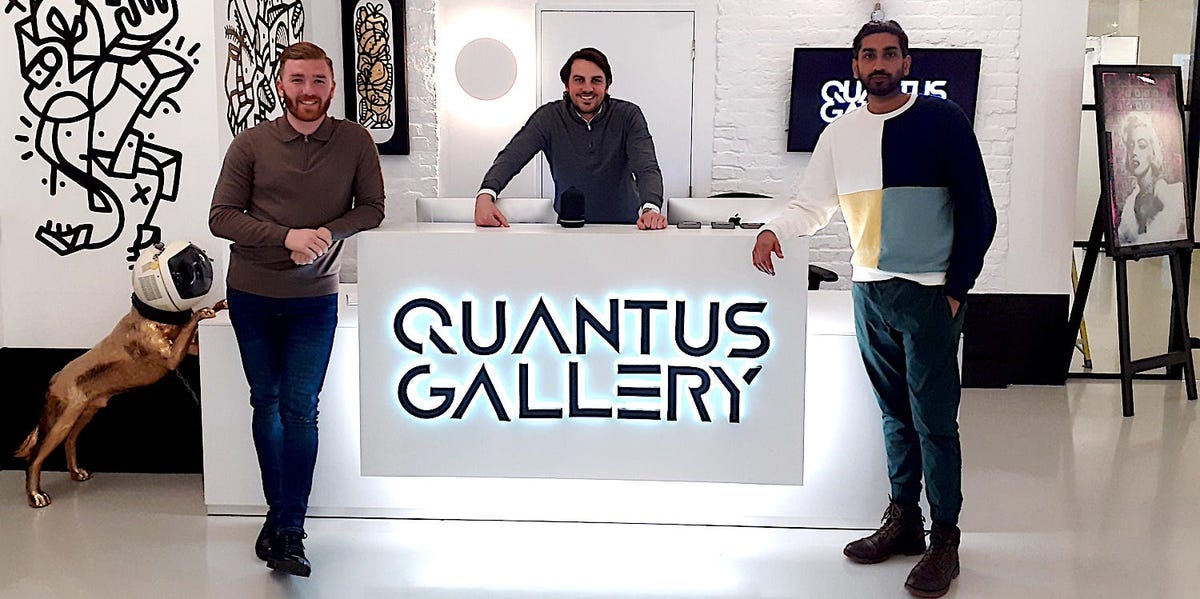
See inside an NFT art gallery with 36 TV screens, 6 advisors, and space-themed dog sculptures. Investors can pay however they want.
Stephen Jones / Insider
- Quantus Gallery is London’s first permanent NFT art gallery. Insider took a tour.
- NFTs are displayed on 36 TVs, alongside dog sculptures and physical pieces of art.
- It has six in-house advisors to educate visitors about how to make, buy, and sell NFTs.
The idea of a physical art gallery that is dedicated to selling digital artworks seems slightly paradoxical.
But Josh Sandhu, James Ryan, and Ryan Marsh say it’s the next logical step of a global market that surged to $41 billion in 2021, which is why they’ve opened what is London’s first permanent NFT art gallery, Quantus Gallery.
An NFT — or non-fungible token — is a digital asset built onto a blockchain. It essentially provides a unique record of ownership. Many consider them to be modern-day collectibles.
Some consider NFTs as the future of art and highlight the fact that established art auction houses Christie’s and Sotheby’s are already in on the trend. Skeptics say it’s a volatile asset and any popularity is merely a bubble.
Quantus’ three co-founders have backgrounds in graphic design, art galleries, and finance respectively. They said they want to appeal to the “95% of people” who don’t yet fully understand the asset. Opening a physical gallery offers something different, and gives more people a way into the market, they add.
Intrigued, curious and slightly skeptical, Insider went along to see what it’s like.
Stephen Joned / Insider
Stephen Jones/ Insider
Stephen Jones / Insider
NFTs are displayed on 36 screens spread across the wall and pillars. There’s also some physical art, including sculptures featuring what appear to be dogs, wearing space helmets.
Stephen Jones / Insider
Electronic music plays and visitors are offered a drink if they fancy. The aim is to create a “feel-good atmosphere,” said Ryan, who also owns a traditional art business Grove Square Galleries.
Stephen Jones / Insider
An NFT collection by the artist Pierre Benjamin, features cartoon-esque portraits of celebrities — including a clown that looks suspiciously like UK Prime Minister Boris Johnson.
Stephen Jones / Insider
Physical art by Bluntroller and Glen Fox can also be purchased as NFTs.
They cost anywhere between the equivalent of £5000 ($6570) up to £15,000 ($19,710) based on the collection.
Payments are designed to be as flexible as possible, with investors able to buy art using crypto but also traditional currency, Sandhu said.
Stephen Jones / Insider
Quantus makes money like a regular art gallery by taking a percentage of profits made by artists, Ryan tells Insider. It differs depending on each contract but could be as much as 15-20%.
Stephen Jones / Insider
The gallery’s 13 staff includes a six-person in-house advisory team, whose job is to educate visitors about how to make, buy, and sell NFTs.
The trio say this is what sets Quantus apart from other NFT galleries that have been established around the world.
Stephen Jones / Insider
Quantus also plan to monetize the space by partnering with brands and community organizations.
OpenSea
The group say they’ve been accused by some of “ruining” the NFT market by taking it offline. One self-proclaimed representative of the “NFT community” even phoned them to voice their disgust.
But there are more legitimate reasons to be critical of NFTs.
Mere days before Insider’s visit to Quantus, the US DOJ charged two men with wire fraud and conspiracy to commit money laundering for their role in the $1.million ‘Frosties’ NFT scam. Ethan Nguyen and Andre Llacuna allegedly vanished shortly after selling all the tokens for their ice-cream inspired NFT.
It’s one of a number of recent high profile ‘rug-pulls’ — scams where apparently legitimate creators cash out their gains, leaving investors with nothing — and other NFT related crimes.
Critics also highlight the environmental impact of creating and maintaining assets on the blockchain.
Stephen Jones / Insider
Scammers can sometimes take advantage of people’s lack of knowledge, Marsh said.
Anyone can set up online but having a five-year lease and being able to speak face to face with people makes Quantus accountable, Ryan added. “You make a statement by having a physical premise,” he said.
They insist Quantus is already set up to anticipate any potential regulations that could come into place — for example, by paying £600 a month for anti-money laundering compliance required by regular art dealers.
The trio are open about the fact that the gallery is a risk but want to set a precedent.
“There could well be a market correct but we know we’re in this in for the long haul. We need to make this work,” Ryan said.
Time will ultimately tell how safe a bet it is.
This content was originally published here.


